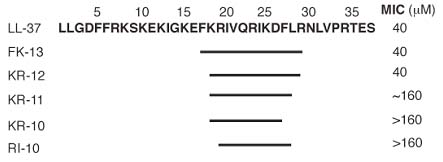
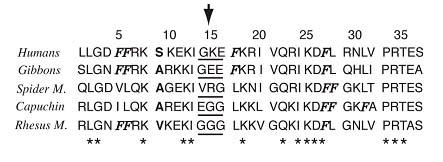
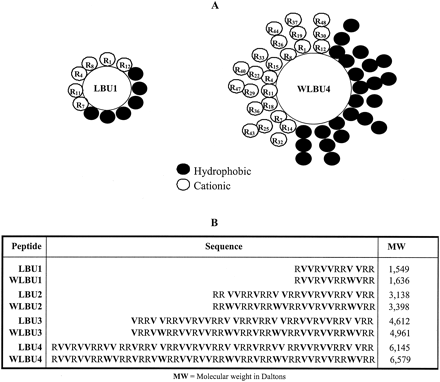
Peptide design. (A) The cationic amphipathic peptides were designed as demonstrated in helical wheel diagrams. Arg, Val, and Trp residues were arranged to form idealized amphipathic alpha-helices, with the hydrophilic and hydrophobic faces indicated in clear and shaded circles, respectively. The 12- and 48-mers LBU1 and WLBU4 are shown as representatives of the LBU and WLBU series, respectively. (B) Primary sequences of the LBU and WLBU peptides used in the present study. The shortest peptide forms one lytic base unit (LBU1) of 12 amino acids, and the others were designed as multimers (2, 3, and 4) of LBU1. The WLBU peptides were derived from the LBU series by substituting Trp residues at the indicated positions. Not shown here are the peptide hydrophobic moments calculated according to the method of Eisenberg et al. (J. Cell Biochem. 31:11-17.).
Deslouches B, et al. Antimicrob Agents Chemother. 2005 Jan;49(1):316-22.
|
Alignment of RL-37, LL-37 and LL-37 pentamide sequence |
|||
|
|
|||
| Peptide | Primary sequencea | Avg mass (Da) | Net charge |
|
|
|||
| RL-37 | RLGNFFRKVKEKIGGGLKKVGQKIKDFLGNLVPRTAS | 4,100.9 | +8 |
| LL-37 | LLGDFFRKSKEKIGKEFKRIVQRIKDFFRNLVPRTES | 4,527.3 | +6 |
| LL-37 pentamide | LLGNFFRKSKQKIGKQFKRIVQRIKNFFRNLVPRTQS | 4,522.3 | +11 |
|
|
|||
| a The five amides that were introduced into the LL-37 pentamide sequence are shown in boldface type. Residues of RL-37 that are identical to those in LL-37 are underlined. | |||
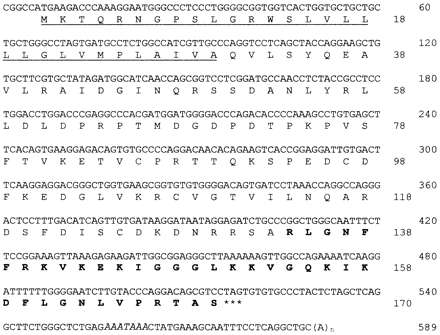
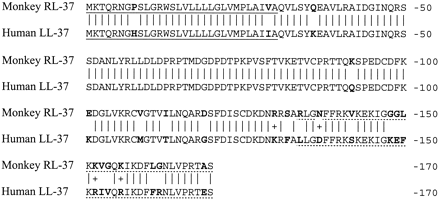
The presence of antimicrobial peptides (AMPs) in saliva may be a biological factor that contributes to susceptibility or resistance to caries. This manuscript will review AMPs in saliva, consider their antimicrobial and immunomodulatory functions, and evaluate their potential role in the oral cavity for protection of the tooth surface as well as the oral mucosa. These AMPs are made in salivary gland and duct cells and have broad antimicrobial activity. Alpha-defensins and LL37 are also released by neutrophils into the gingival crevicular fluid. Both sources may account for their presence in saliva. A recent study in middle school children aimed to determine a possible correlation between caries prevalence in children and salivary concentrations of the antimicrobial peptides human beta-defensin-3 (hBD-3), the cathelicidin, LL37, and the alpha-defensins. The levels of these AMPs were highly variable in the population. While levels of LL37 and hBD-3 did not correlate with caries experience, the mean alpha-defensin level was significantly higher in children with no caries than in children with caries (p < 0.005). We conclude that several types of AMPs that may have a role in oral health are present in unstimulated saliva. Low salivary levels of alpha-defensin may represent a biological factor that contributes to caries susceptibility. Our observation could lead to new ways to prevent caries and to a new tool for caries risk assessment.
Dale BA, Tao R, Kimball JR, Jurevic RJ. Oral antimicrobial peptides and biological control of caries. BMC Oral Health. 2006;6 Suppl 1:S13.
The antimicrobial activity of the collective molecules comprising human milk reflects an evolutionarily successful paradigm for preventing and limiting microbial infection. Understanding the molecules that participate in this process and how they work can yield insight into potentially new antimicrobial therapies. Upon proteolytic processing, antimicrobial peptides can be derived from milk proteins, such as lactoferrin, casein, and lysozyme. Similarly, using the HIV-1 gp41 protein template, we have demonstrated that the 28-residue C-terminus, when produced as an independent peptide, exhibits selective toxicity for bacteria over eukaryotic cells. Upon optimizing this sequence for cationic charge and hydrophobic character presented as a alpha-helical structure, we show improved capability of the parent LLP1 sequence to selectively kill bacteria in the host environment and that this activity is increased by the inclusion of Trp residues on the hydrophobic face. We report that it is possible to (i) design de novo antimicrobial peptides that demonstrate optimal antimicrobial activity with minimal inflammatory activity and (ii) design antimicrobial peptides to function in a defined environment. In the end, we describe a de novo designed antimicrobial peptide, WLBU2, which is selectively toxic to microbial pathogens in complex environments and does not stimulate a significant immunomodulatory response. In spite of these properties, WLBU2 activity against Pseudomonas aeruginosa in human milk is inferior to the host peptide LL37 with regard to antimicrobial potency. These studies demonstrate that antimicrobial peptides can be engineered for greater potency in one medium but may not be optimal for working in a different medium such as human milk.
Phadke SM, Deslouches B, Hileman SE, Montelaro RC, Wiesenfeld HC, Mietzner TA. Antimicrobial peptides in mucosal secretions: the importance of local secretions in mitigating infection. J Nutr. 2005;135(5):1289-93.
The human cathelicidin anti-microbial protein, hCAP18 is a component of the innate immune system and has broad anti-microbial activity conferred by its C-terminal fragment LL-37. hCAP18 is constitutively produced in leukocytes and is induced in barrier organs upon inflammation and infection. We demonstrate here a novel role for this peptide in re-epithelialization of skin wounds. We show that high levels of hCAP18 are produced in skin in vivo upon wounding. The highest hCAP18 levels are attained at 48 h post-injury, declining to pre-injury levels upon wound closure. hCAP18 is detected in the inflammatory infiltrate and in the epithelium migrating over the wound bed. In chronic ulcers, however, hCAP18 levels are low and immunoreactivity for hCAP18/LL-37 is absent in ulcer edge epithelium. Using a noninflammatory ex vivo wound healing model, composed of organ-cultured human skin, we show that hCAP18 is strongly expressed in healing skin epithelium, and that treatment with antibodies raised and affinity purified against LL-37, inhibits re-epithelialization in a concentration-dependent manner. Immunoreactivity for the proliferation marker Ki67 is absent in the epithelium of such inhibited wounds, suggesting that LL-37 may play a part in epithelial cell proliferation. Thus, we suggest that, in addition to being an anti-microbial peptide, LL-37 also plays a part in wound closure and that its reduction in chronic wounds impairs re-epithelialization and may contribute to their failure to heal.
Heilborn JD, Nilsson MF, Kratz G, et al. The cathelicidin anti-microbial peptide LL-37 is involved in re-epithelialization of human skin wounds and is lacking in chronic ulcer epithelium. J Invest Dermatol. 2003;120(3):379-8.
Leukocytes accumulate at sites of inflammation and immunological reaction in response to locally existing chemotactic mediators. N-formyl peptides, such as fMet-Leu-Phe (fMLF), are some of the first identified and most potent chemoattractants for phagocytic leukocytes. In addition to the bacterial peptide fMLF and the putative endogenously produced formylated peptides, a number of novel peptide agonists have recently been identified that selectively activate the high-affinity fMLF receptor FPR and/or its low-affinity variant FPRL1, both of which belong to the seven-transmembrane (STM), G protein-coupled receptor (GPCR) superfamily. These agonists include peptide domains derived from the envelope proteins of human immunodeficiency virus type 1 (HIV-1) and at least three amyloidogenic polypeptides, the human acute phase protein serum amyloid A, the 42 amino acid form of beta amyloid peptide and a 21 amino acid fragment of human prion. Furthermore, a cleavage fragment of neutrophil granule-derived bactericidal cathelicidin, LL-37, is also a chemotactic agonist for FPRL1. Activation of formyl peptide receptors results in increased cell migration, phagocytosis, release of proinflammatory mediators, and the signaling cascade culminates in heterologous desensitization of other STM receptors including chemokine receptors CCR5 and CXCR4, two coreceptors for HIV-1. Thus, by interacting with a variety of exogenous and host-derived agonists, formyl peptide receptors may play important roles in proinflammatory and immunological diseases and constitute a novel group of pharmacological targets.
Le Y, Yang Y, Cui Y, et al. Receptors for chemotactic formyl peptides as pharmacological targets. Int Immunopharmacol. 2002;2(1):1-13.
The mast cell is one of the major effector cells in inflammatory reactions and can be found in most tissues throughout the body. During inflammation, an increase in the number of mast cells in the local milieu occurs, and such accumulation requires directed migration of this cell population. As it has previously been reported that the human cathelicidin-derived antibacterial peptide, LL-37, stimulates the degranulation of mast cells, we hypothesized that LL-37 could be a mast cell chemotaxin. The present study shows that LL-37 is a potent chemotactic factor for mast cells. The chemotactic response was dose-dependent and bell-shaped, reaching an optimal concentration of 5 &mgr;g/ml. In addition, checkerboard analysis showed that cell migration towards this peptide was chemotactic rather than chemokinetic. Moreover, Scatchard analysis using 125I-labelled LL-37-derived peptide revealed that LL-37 has at least two classes of receptors, namely high- and low-affinity receptors, on mast cells. Furthermore, the competitive binding assay suggested that LL-37 is unlikely to utilize formyl peptide receptor-like 1 (FPRL1), a functional LL-37 receptor for neutrophil and monocyte migration, on mast cells. In addition, the treatment of cells with pertussis toxin and phospholipase C inhibitor, U-73122, inhibited LL-37-mediated migration, indicating that LL-37 induces mast cell chemotaxis through a Gi protein-phospholipase C signalling pathway. These results show that besides its antibacterial activities, LL-37 may have the potential to recruit mast cells to inflammation foci. CONCLUSIONS: A deficiency in the expression of antimicrobial peptides may account for the susceptibility of patients with atopic dermatitis to skin infection with S. aureus.
Niyonsaba F, Iwabuchi K, Someya A, et al. A cathelicidin family of human antibacterial peptide LL-37 induces mast cell chemotaxis. Immunology. 2002;106(1):20-6.
BACKGROUND: The innate immune system of human skin contains antimicrobial peptides known as cathelicidins (LL-37) and beta-defensins. In normal skin these peptides are negligible, but they accumulate in skin affected by inflammatory diseases such as psoriasis. We compared the levels of expression of LL-37 and human beta-defensin 2 (HBD-2) in inflamed skin from patients with atopic dermatitis and from those with psoriasis.
METHODS: The expression of LL-37 and HBD-2 protein in skin-biopsy specimens from patients with psoriasis, patients with atopic dermatitis, and normal subjects was determined by immunohistochemical analysis. The amount of antimicrobial peptides in extracts of skin samples was also analyzed by immunodot blot analysis (for LL-37) and Western blot analysis (for HBD-2). Quantitative, real-time reverse-transcriptase-polymerase-chain-reaction (RT-PCR) assays were used to confirm the relative expression of HBD-2 and LL-37 messenger RNA (mRNA) in the skin-biopsy specimens. These peptides were also tested for antimicrobial activity against Staphylococcus aureus with the use of a colony-forming assay.
RESULTS: Immunohistochemical analysis confirmed the presence of abundant LL-37 and HBD-2 in the superficial epidermis of all patients with psoriasis. In comparison, immunostaining for these peptides was significantly decreased in acute and chronic lesions from patients with atopic dermatitis (P=0.006 and P=0.03, respectively). These results were confirmed by immunodot blot and Western blot analyses. Real-time RT-PCR showed significantly lower expression of HBD-2 mRNA and LL-37 mRNA in atopic lesions than in psoriatic lesions (P=0.009 and P=0.02, respectively). The combination of LL-37 and HBD-2 showed synergistic antimicrobial activity by effectively killing S. aureus.
Ong PY, Ohtake T, Brandt C, et al. Endogenous antimicrobial peptides and skin infections in atopic dermatitis. N Engl J Med. 2002;347(15):1151-60.
Endogenous antimicrobial peptides of the cathelicidin family contribute to innate immunity. The emergence of widespread antibiotic resistance in many commonly encountered bacteria requires the search for new bactericidal agents with therapeutic potential. Solid-phase synthesis was employed to prepare linear antimicrobial peptides found in cathelicidins of five mammals: human (FALL39/LL37), rabbit (CAP18), mouse (mCRAMP), rat (rCRAMP), and sheep (SMAP29 and SMAP34). These peptides were tested at ionic strengths of 25 and 175 mM against Pseudomonas aeruginosa, Escherichia coli, Staphylococcus aureus, and methicillin-resistant Staphylococcus aureus. Each peptide manifested activity against P. aeruginosa irrespective of the NaCl concentration. CAP18 and SMAP29 were the most effective peptides of the group against all test organisms under both low- and high-salt conditions. Select peptides of 15 to 21 residues, modeled on CAP18 (37 residues), retained activity against the gram-negative bacteria and methicillin-sensitive S. aureus, although the bactericidal activity was reduced compared to that of the parent peptide. In accordance with the behavior of the parent molecule, the truncated peptides adopted an alpha-helical structure in the presence of trifluoroethanol or lipopolysaccharide. The relationship between the bactericidal activity and several physiochemical properties of the cathelicidins was examined. The activities of the full-length peptides correlated positively with a predicted gradient of hydrophobicity along the peptide backbone and with net positive charge; they correlated inversely with relative abundance of anionic residues. The salt-resistant, antimicrobial properties of CAP18 and SMAP29 suggest that these peptides or congeneric structures have potential for the treatment of bacterial infections in normal and immunocompromised persons and individuals with cystic fibrosis.
Travis SM, Anderson NN, Forsyth WR, et al. Bactericidal activity of mammalian cathelicidin-derived peptides. Infect Immun. 2000;68(5):2748-55.
We have previously shown that antimicrobial peptides like defensins have the capacity to mobilize leukocytes in host defense. LL-37 is the cleaved antimicrobial 37-residue, COOH-terminal peptide of hCAP18 (human cationic antimicrobial protein with a molecular size of 18 kD), the only identified member in humans of a family of proteins called cathelicidins. LL-37/hCAP18 is produced by neutrophils and various epithelial cells. Here we report that LL-37 is chemotactic for, and can induce Ca(2+) mobilization in, human monocytes and formyl peptide receptor-like 1 (FPRL1)-transfected human embryonic kidney 293 cells. LL-37-induced Ca(2+) mobilization in monocytes can also be cross-desensitized by an FPRL1-specific agonist. Furthermore, LL-37 is also chemotactic for human neutrophils and T lymphocytes that are known to express FPRL1. Our results suggest that, in addition to its microbicidal activity, LL-37 may contribute to innate and adaptive immunity by recruiting neutrophils, monocytes, and T cells to sites of microbial invasion by interacting with FPRL1.
De yang, Chen Q, Schmidt AP, et al. LL-37, the neutrophil granule- and epithelial cell-derived cathelicidin, utilizes formyl peptide receptor-like 1 (FPRL1) as a receptor to chemoattract human peripheral blood neutrophils, monocytes, and T cells. J Exp Med. 2000;192(7):1069-74.
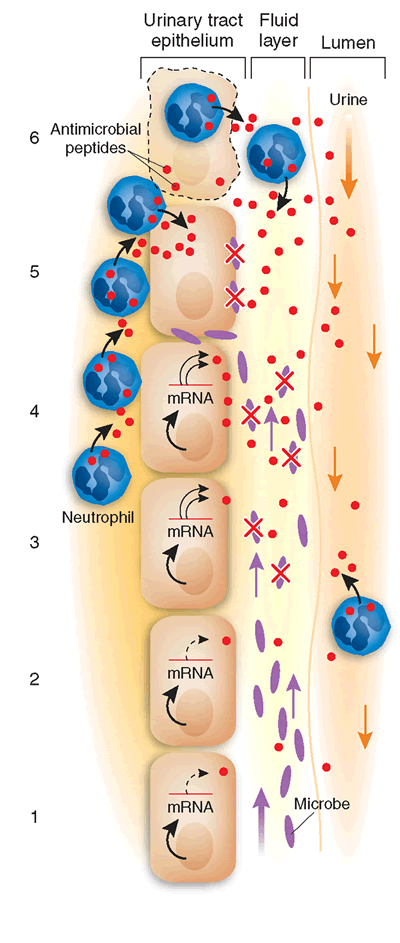 |
|
| Catalog# | Product | Standard Size | Price |
|---|---|---|---|
| 075-06 | LL37 (Human) | 200 µg | $242 |
| 075-31 | LL37 (17-29) / FK-13 (Human) | 100 µg | $152 |
| 075-30 | LL37 (18-29) / KR-12 (Human) | 500 µg | $167 |
| 075-06A | [Tyr0]-LL37 (Human) | 100 µg | $952 |
| H-075-06 | LL37 (Human) - Antibody | 50 µl | $571 |
| B-075-06 | LL37 (Human) - Biotin Labeled | 20 µg | $444 |
| B-G-075-06 | LL37 (Human) - Biotin Labeled Purified IgG | 100 µl | $635 |
| DBK-075-06 | LL37 (Human) - Dot Blot Kit | 5 blots | $761 |
| FG-075-06A | LL37 (Human) - FAM Labeled | 1 nmol | $508 |
| FG-G-075-06A | LL37 (Human) - FAM Labeled Purified IgG | 100 µl | $635 |
Social Network Confirmation